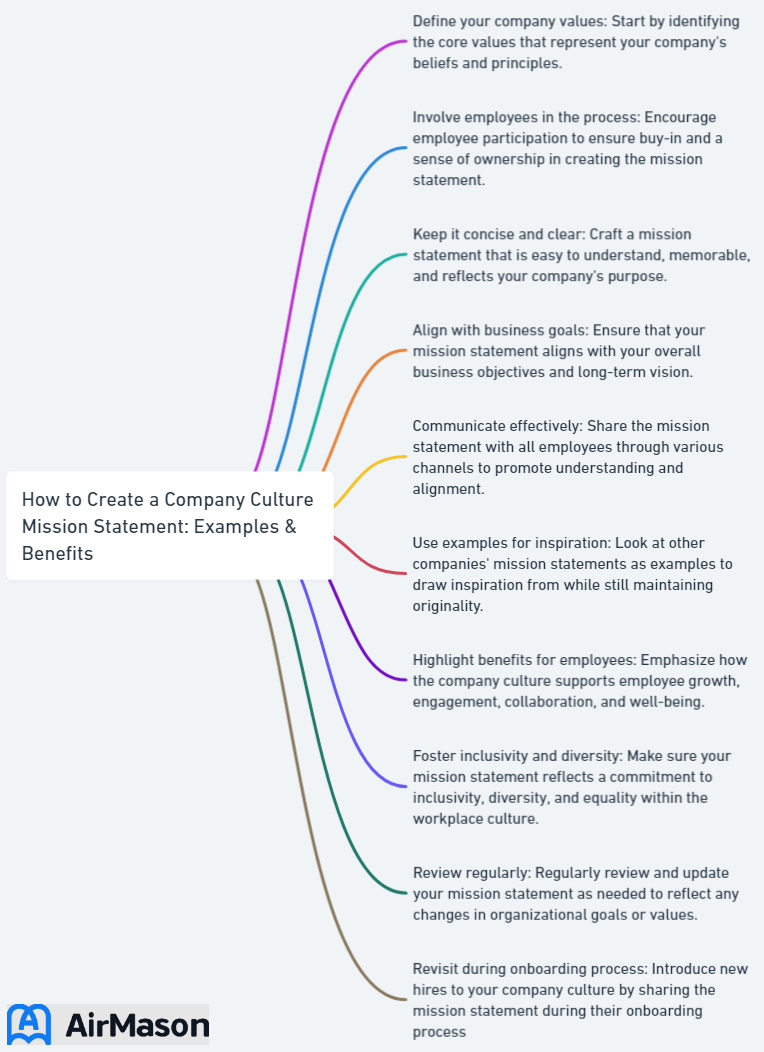
In today’s competitive business world, establishing a strong company culture and mission statement is crucial for success. Not only does it help to set your organization apart from the competition, but it also serves as a guiding force for employee engagement, attracting top talent, and overall business performance. So, how do you create a company culture mission statement that truly represents your organization’s values and goals? Let’s dive into the process and explore some real-life culture mission statement examples for inspiration.
Key Takeaways
- Understand company culture and mission statements to create a powerful statement that reflects core values.
- Involve employees in crafting an authentic, specific mission statement for increased engagement & satisfaction.
- Realize benefits such as improved business performance and attracting/retaining top talent with a strong company culture mission statement.
Understanding Company Culture and Mission Statements
Company culture is the foundation of an organization’s culture, encompassing the shared values, beliefs, and behaviors that shape the way employees interact and make decisions. A strong company culture fosters a positive work environment, leading to engaged employees and improved business performance. On the other hand, mission statements define the overarching goals and objectives of an organization, providing direction for its operations while communicating its values and purpose to employees, customers, and stakeholders.
Grasping the relationship between company culture and culture statement is a key element in developing a potent statement that guides actions and communicates values to stakeholders. A well-crafted statement not only reflects the core values and purpose of the organization but also serves as a beacon that steers employee behavior and decision-making, ultimately shaping the organization’s culture.

Defining Company Culture
Company culture, also known as a company’s culture or culture code, is the unique blend of values, beliefs, and practices that shape an organization’s identity and the way employees interact with one another and the company as a whole. To describe company culture, one can look at the core values, such as:
- Integrity
- Respect
- Excellence
- Innovation
- Diversity
In essence, workplace culture is the manifestation of these core values in the daily interactions and operations of the organization.
An organization’s values serve as the foundation for company culture, guiding employee actions and decision-making. These values provide a framework for ethical behavior and help shape the company’s identity and reputation.
While a great company culture can lead to increased employee engagement, productivity, and retention, a negative culture can have the opposite effect, impacting employee morale, turnover, and overall business success. Therefore, it’s vital to evaluate, articulate, and cultivate a positive company culture that mirrors the organization’s mission and values.
The Role of Mission Statements
Mission statements play a vital role in providing a clear direction for a company’s goals and objectives, helping to align employees and stakeholders with the organization’s purpose. A well-defined mission statement serves as a guide for the organization’s activities and decision-making, describing the company culture and conveying values and purpose to employees, customers, and stakeholders.
Mission statements serve several important purposes in an organization:
- Foster cooperation among employees and stakeholders
- Allow stakeholders to comprehend the organization’s purpose and align with it
- Inform business decisions
- Motivate employees
- Reflect the core values of the organization
- Contribute to the success of the company by fostering innovation
- Empower employees to work towards realizing the organization’s strategy
An Organization’s Culture
An organization’s culture is the invisible thread that weaves together its values, beliefs, and behaviors into a cohesive fabric that shapes the work environment. It encompasses the collective mindset of employees, influencing how they interact, collaborate, and innovate within the company. This culture can be either nurtured intentionally or allowed to evolve organically, but it always leaves an indelible mark on the organization’s identity. A healthy organizational culture fosters a sense of belonging and encourages individuals to bring their authentic selves to work, promoting creativity and productivity. Conversely, a toxic or dysfunctional culture can lead to high turnover, low morale, and hindered performance. Recognizing the pivotal role of culture is paramount for leaders aiming to build resilient and successful organizations.
Crafting a Company Culture Mission Statement

Developing a company culture mission statement is a significant process that demands careful consideration of the organization’s core values, coupled with employee participation in the formulation process. A well-crafted mission statement should be:
- Specific
- Authentic
- Accurately reflect the company culture
- Ensure it resonates with employees and stakeholders alike.
The subsequent sections will detail the steps needed to create a company culture mission statement, which includes identifying core values, encouraging employee participation, and crafting a specific and authentic statement. By following these steps, your organization can create a powerful mission statement that truly represents its values and goals.
Identify Core Values
Identifying core values is the first step in crafting a company culture mission statement. Core values are the fundamental principles that guide a company’s culture, informing how employees and clients are treated, and how business operations are conducted. Common core values include:
- Integrity
- Accountability
- Innovation
- Teamwork
- Customer focus
Recognizing your business’s core values necessitates an evaluation of the present organizational culture, a review of the strategic business plan, and identification of the culture required to realize the plan. By aligning the mission statement with the core values, you can create a strong foundation for your company culture and ensure that it accurately reflects your organization’s purpose and goals.
Involve Employees in the Process
Including employees in the formulation of the mission statement is vital for its accurate reflection of the company culture and for fostering an atmosphere of ownership and commitment among team members. By seeking input from employees, you can gain valuable insights into their perspectives, values, and aspirations, allowing you to create a statement that resonates with the entire company.
There are various strategies to involve employees in the process, such as holding meetings, conducting surveys, or organizing focus groups to gain employee feedback. By incorporating their input, you can create a mission statement that not only reflects the collective identity and objectives of your employees but also fosters a sense of belonging and commitment within the organization.
Be Specific and Authentic
Being specific and authentic is crucial while formulating a company culture mission statement. A clear, concise statement that accurately reflects the values of the organization will resonate with employees and stakeholders alike. Avoid using generic language or clichés that fail to capture the unique essence of your company culture.
By being specific and authentic in your company culture mission statement, you can create a message that not only accurately represents your organization’s values and goals but also helps to engage and inspire employees. This, in turn, can lead to a stronger company culture, improved employee engagement, and overall business success.
Benefits of a Strong Company Culture Mission Statement

A strong company culture mission statement offers numerous benefits, including increased employee engagement and satisfaction, attracting and retaining top talent, and improved business performance. By accurately reflecting the organization’s values and goals, a well-crafted mission statement can foster a positive work environment, promote a sense of belonging and commitment among employees, and align personal and company values.
The subsequent sections will further discuss the specific benefits of a robust company culture mission statement and its impact on employee engagement and satisfaction, talent attraction and retention, and overall business performance.
Employee Engagement and Satisfaction
Employee engagement and satisfaction are critical factors in the success of any organization. A robust company culture mission statement can enhance employee engagement and satisfaction through alignment of personal and company values, while cultivating a sense of belonging and commitment among team members. Employees who feel connected to the organization’s mission and values are more likely to be dedicated, motivated, and productive.
Furthermore, research shows that companies with a highly engaged workforce are 21% more profitable. By creating a strong company culture mission statement that accurately reflects the organization’s values and goals, you can cultivate a positive work environment where employees feel valued and appreciated. This will ultimately help to engage employees, leading to increased engagement, satisfaction, and overall business success.
Attracting and Retaining Top Talent
For any organization to flourish in today’s competitive business environment, attracting and retaining top talent is crucial. A strong company culture mission statement can play a significant role in attracting and retaining top talent by communicating the organization’s values and goals, helping potential candidates determine if it’s a good fit.
A positive company culture creates an environment in which employees are enthusiastic to attend work and take pride in their accomplishments, as their input is valued. By showcasing a strong company culture in your company culture statements, such as the mission statement, you can appeal to job seekers who prioritize a supportive and inclusive work environment, ultimately making it easier to attract and retain high-quality talent.
Improved Business Performance
A robust company culture mission statement directly contributes to improved business performance. When employees are aligned with the organization’s values and goals, they are more likely to be engaged, productive, and committed to the company’s success. A strong mission statement also promotes a positive work environment, which can lead to increased employee satisfaction, reduced turnover, and improved overall performance.
By crafting a company culture mission statement that accurately reflects the organization’s values and goals, you can create a sense of unity and purpose among your employees. This, in turn, can lead to improved business performance, as employees work together to achieve the organization’s objectives and contribute to its overall success.
Creating a Better Work Place
A better work place is not just a physical environment; it encompasses a holistic approach to fostering a positive and productive atmosphere for employees. To establish a better work place, organizations must prioritize employee well-being and satisfaction. This can be achieved through initiatives such as flexible work arrangements, ergonomic workstations, and inclusive policies. Moreover, open lines of communication and regular feedback mechanisms contribute significantly to a better work place, allowing employees to voice their concerns and suggestions. Additionally, investing in professional development opportunities and recognizing employees’ achievements can boost morale and create a sense of belonging. Ultimately, a better work place is characterized by a culture of respect, collaboration, and continuous improvement, ensuring that employees thrive and contribute their best to the organization.
Real-Life Examples of Company Culture Mission Statements

Real-life examples of company culture mission statements can provide inspiration and guidance for crafting your own statement. By examining the mission statements of successful organizations, you can gain insights into how they communicate their values, goals, and culture to employees and stakeholders.
The subsequent sections will discuss some real-life examples of company culture mission statements, underscoring how these organizations articulate their values, goals, and culture through their statements. These examples can serve as a valuable resource and inspiration for crafting your own powerful and effective company culture mission statement.
Example 1: Company A
Company A’s mission statement emphasizes innovation, collaboration, and a commitment to customer satisfaction, reflecting their core values and guiding employee actions. By focusing on these key aspects, Company A has created a culture that fosters creativity, teamwork, and a strong focus on meeting customer needs.
This mission statement not only communicates the organization’s values and goals but also serves as a guiding force for employees, helping them to align their actions and decisions with the company’s objectives. As a result, Company A has experienced significant growth and success, driven by a strong company culture and a clear sense of purpose, which is also reflected in their vision statement.
Example 2: Company B
Company B’s mission statement focuses on sustainability, social responsibility, and employee empowerment, showcasing their unique company culture and values. By committing to these principles, Company B has positioned itself as a leader in its industry, attracting top talent and inspiring loyalty among its employees.
This mission statement demonstrates Company B’s dedication to:
- Environmental responsibility
- Creating value through sustainable practices
- Empowering employees
- Promoting a culture of continuous improvement
By clearly articulating these values and goals, Company B has created a strong company culture mission statement that resonates with its employees and stakeholders.
Example 3: Company C
Company C’s mission statement highlights their dedication to:
- Employee growth
- Diversity
- Inclusion
- Creating a supportive and nurturing work environment
This focus on employee well-being and personal development has helped Company C attract and retain top talent, fostering a diverse and inclusive workforce that drives innovation and success.
By emphasizing these values in its mission statement, Company C has successfully cultivated a culture that encourages employee growth and nurtures a diverse and inclusive community. This strong company culture has not only contributed to the organization’s success but also helped to create a positive and engaging work environment for its employees.
Example 4: Company D
Company D’s mission statement showcases their commitment to excellence, continuous improvement, and a results-driven approach, aligning employees with the organization’s goals and objectives. By emphasizing these values in its mission statement, Company D has created a culture that fosters a relentless pursuit of excellence and improvement, inspiring employees to strive for the best possible outcomes.
This mission statement not only communicates Company D’s values and goals but also serves as a motivational force for employees, encouraging them to take ownership of their work and constantly strive for improvement. As a result, Company D has experienced significant growth and success, driven by a strong company culture and a shared sense of purpose.
Supportive Work Culture: Fostering Employee Well-being and Productivity
A supportive work culture is the cornerstone of a thriving and harmonious workplace environment. It encompasses a range of practices and policies aimed at prioritizing the well-being and professional growth of employees. In an organization with a supportive work culture, team members feel valued, heard, and empowered to contribute their best efforts. This environment promotes open communication, trust, and collaboration, laying the foundation for innovation and productivity. Additionally, it acknowledges the diverse needs and aspirations of employees, offering resources and initiatives that cater to their individual growth trajectories. Ultimately, a supportive work culture not only boosts morale but also cultivates a sense of belonging, leading to higher retention rates and a more engaged workforce.
Summary
In conclusion, crafting a strong company culture mission statement is crucial for organizations looking to foster a positive work environment, attract and retain top talent, and drive business success. By identifying core values, involving employees in the process, and being specific and authentic in the statement, your organization can create a powerful mission statement that truly represents its values and goals. By learning from real-life examples and following these steps, you can develop a compelling company culture mission statement that will serve as a guiding force for your organization and inspire your employees to reach their full potential.
Frequently Asked Questions
What is an example of a culture statement?
An example of a culture statement is “We value diversity, curiosity, and caring — for customers, teammates, and your work. We’re mission-driven, customer obsessed, and agile, but we also work hard to be diverse, inclusive, and empowering for our team members.”
What is mission statement culture?
Mission statement culture is a collective personality of your team that reflects and supports the declared business strategy, to be shared with customers and the wider community.
How do you write a cultural statement?
To write a Cultural Statement, provide an overview of the cultural community or practice you are referencing, and explain how it has shaped your work. Include any cultural history or stories that have informed your work, and conclude with a clear and professional summary of the implications.
What are some examples of core values that can be included in a company culture mission statement?
Integrity, accountability, innovation, teamwork and customer focus are core values that can be included in a company culture mission statement to provide a framework for ethical behavior and shape the company’s identity.
How can a strong company culture mission statement impact employee engagement and satisfaction?
A strong company culture mission statement can enhance employee engagement and satisfaction by aligning values, fostering a sense of belonging and commitment, and creating a positive work environment.